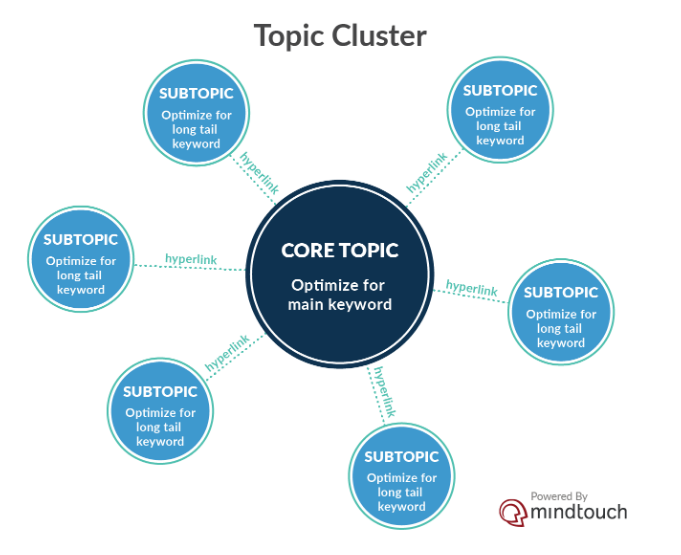What are topic clusters? You can create a topic cluster using “workout routines” as the pillar. Each cluster has a pillar and related cluster content. Choosing the right topics Now that you understand the basics, it’s time for you to start building topic clusters. But before you can start producing content, you need to choose the right pillars that will drive results. Build your pillar pages Once all your content has been produced, it’s time to publish everything. Start by building your pillar pages. Distribute your content As you now know, your topic clusters will help SEO. Looking toward the future, it’s important for you to start improving your SEO strategy today. After you produce and publish your content, you need to make sure your site architecture is formatted for SEO purposes and sitelinks.
To survive in today’s competitive digital landscape, businesses need to focus on their content strategies now more than ever.
You need to understand how your target audience consumes content and figure out what they’re looking for. It’s not effective to produce random content at a high rate if it’s not valuable.
Everything you publish across all your distribution channels needs to benefit your audience, or it won’t be successful.
In addition to producing high quality content, you also want to make sure it’s SEO-friendly.
The key factor of your content production needs to be relevancy: 78% of consumers say relevant content increases their intent to buy.
Your content must be relevant to your brand and relevant to your audience while still appealing to Google.
Blindly producing content without a strategy won’t help you. You need to keep up with the latest trends and see how other brands approach content marketing and SEO.
Today, and in the future, marketers must have a content strategy compatible with the way people discover new content. Creating content that doesn’t drive results is expensive and inefficient.
That’s why you need to get familiar with topic clusters.
Surprisingly, many business owners and marketers I’ve spoken to recently don’t know anything about this. That was my inspiration for writing this guide.
This is the perfect opportunity for you to gain a competitive advantage.
You can learn how to implement topic clusters today and use this tactic moving forward before your competitors have a chance to catch on.
As a result, you’ll be able to produce high quality engaging content. This will help you improve your SEO strategy, drive more traffic to your site, and increase conversion rates.
I’ll explain everything you need to know about topic clusters and how they are revolutionizing the marketing industry.
What are topic clusters?
Before we proceed, let’s start with the basics.
You may have heard that topic clusters are the future of content marketing and SEO strategies, but that doesn’t explain what they are.
Truthfully, this isn’t a very complex topic. If you guessed what a topic cluster is just based on its name, you probably wouldn’t be far off.
The idea here is you want to create a deeper penetration of certain subjects relevant to your brand, audience, and search engines.
Start with one basic topic, then branch off to similar ones. You’ll create content about all of them, with the main area of focus as the nucleus.
Here’s a visual representation of a topic cluster template:

Clusters can be broken down into two segments.
The image above refers to them as core topics and subtopics. However, they are also commonly referred to as pillar content and cluster content.
Your pillar topics will be broad. The clusters will be more descriptive.
For example, let’s say your company sells workout supplements. You can create a topic cluster using “workout routines” as the pillar.
Clusters related to this pillar would be:
- home workout routines
- workout routines to build muscle
- workout routines to lose weight
- outdoor workout routines
- bodyweight workout routines
- workout routines with weights
Each cluster takes a keyword and transforms it into a long-tail keyword.
When you publish such content on your website, you’ll be able to generate lots of internal links, ultimately improving your SEO ranking.
The pillar will link to each cluster, and each cluster will link back to the pillar with internal hyperlinks.
Here’s another example of a topic cluster using “GDPR Compliance” as the pillar:

All of these subtopics are more specific segments of the broad subject. That’s how your audience will search for topics online. These topic clusters will increase your site visibility in search engine results.
Optimize your website architecture
The application of your topic clusters will be related to your site architecture.
You need to make sure this structure is optimized for SEO purposes. Whether you realize it or not, how you design your architecture can determine whether your site is SEO-friendly or not.
You need to think about the user experience.
Make it as easy as possible for website visitors to navigate your site and find what they’re looking for in as few steps as possible.
If your site is structured properly, you won’t have as many bounce rates, and your dwell time will be improved as well. As a result, your search ranking will increase.
Let me show you what I mean.
If you Google Quick Sprout, here is how it appears in the search results:

Sitelinks are subpages of a website that appear in Google SERPs. This will help a user navigate to a more relevant portion of a site, directly from the search engine.
These sitelinks create fewer steps in the conversion funnel. Users can click one of these hyperlinks instead of having to navigate to your homepage first.
Sitelinks are great for SEO purposes. However, you can’t contact Google and choose…

COMMENTS